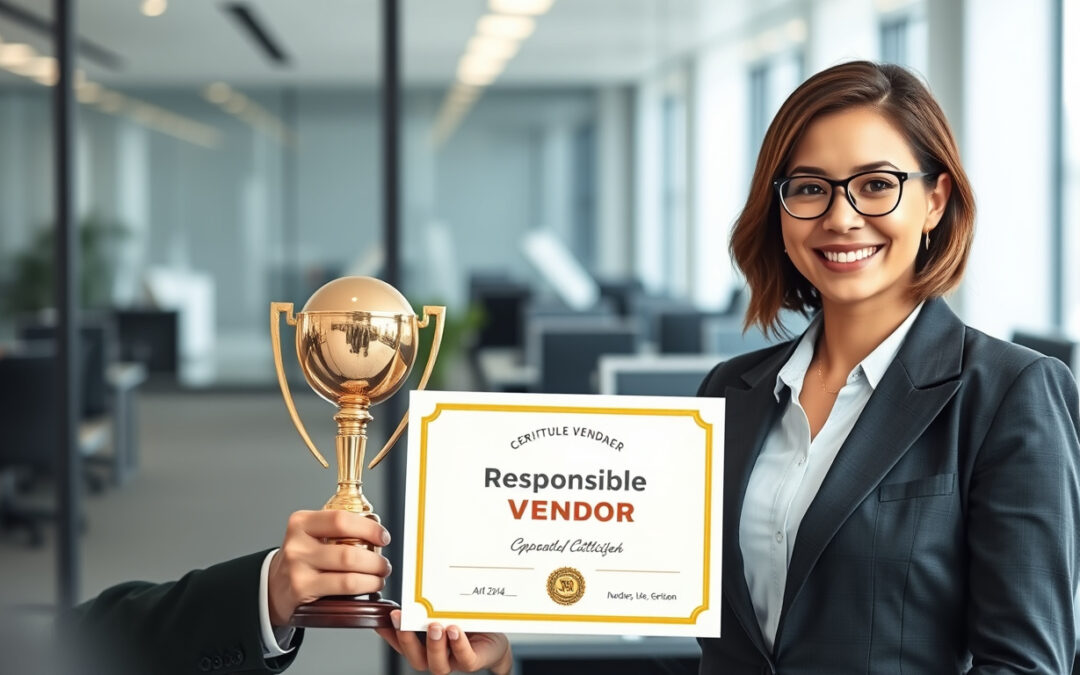
BLOG
In today’s market, trust matters. You earn trust with customers and partners. Responsible vendor certification builds that trust. It shows you act with ethics and care. It also opens new doors for your business. In this guide, we explain how certification helps you, list the steps you take, and show the boost it gives your business.
What Is Responsible Vendor Certification?
Responsible vendor certification gives a company clear praise. It shows that the firm meets ethical, social, and environmental standards. It tells customers, partners, and clients that you follow fair labor practices, protect the environment, and obey laws.
Third-party experts often check these claims. Certified companies prove they act with care and transparency. This status relies on close connections between your work and values.
Why Responsible Vendor Certification Matters for Your Business
Securing this certification can change your business in many ways. Here are the key points:
-
Builds Customer Trust
Buyers like clear proof of ethics. Certification links your business practice with trust.
-
Meets Compliance and Regulatory Requirements
Many sectors require strict rules. Certification shows you meet or beat these rules.
-
Differentiates Your Brand
In a crowded market, you need to stand out. Certification ties your brand to ethics.
-
Expands Business Opportunities
Big companies and governments require ethics checks. Certification can be a key that unlocks larger deals.
-
Improves Supply Chain Transparency
The process makes you look at your supply chain. You reduce risks and gain efficiency.
How to Get Responsible Vendor Certification: Step-by-Step
Follow these clear steps to earn certification.
Step 1: Understand Certification Standards and Requirements
Start by learning the rules. Different bodies use varied standards for labor, environment, and sourcing.
Look at well-known guidelines such as:
- ISO 20400 (Sustainable Procurement)
- Ethical Trading Initiative (ETI) Base Code
- SA8000 Social Accountability International Standard
Know these early. They help you see what you must fix.
Step 2: Conduct a Comprehensive Internal Assessment
Do a careful review of your work. Check your labor policies, environmental systems, and legal compliance. Look at how you work with suppliers.
Record your findings and note gaps.
Step 3: Implement Necessary Improvements
Make changes based on your review. Improve worker safety and fair policies. Use greener methods. Increase transparency with suppliers.
Work with your team and partners to meet these needs.

Step 4: Prepare Documentation
Collect all proof of your responsible actions. Bring together:
- Policy manuals
- Training records
- Audit results
- Environmental reports
Clear documentation speeds up the process.
Step 5: Apply for Certification and Schedule an Audit
Submit your application with all paperwork. The certifiers then plan an onsite or remote review. They check your practice and documents.
Step 6: Receive Certification and Maintain Standards
Once you meet the rules, you get certified. But work does not stop here. Keep improving by holding regular audits and updates.
Key Benefits of Responsible Vendor Certification in Numbers
A 2023 Nielsen survey shows 73% of consumers change habits to help the planet. This shows a clear trend.
The numbers speak:
- 25% Increase in Supplier Contracts: Businesses win more deals.
- 40% Boost in Customer Retention: Customers stay longer with ethical vendors.
- 15-20% Reduction in Supply Chain Risk: Clear supply chains mean less risk.
Best Practices to Leverage Responsible Vendor Certification
Certification is only a start. To get the full benefit, try these tips:
- Promote Your Certification: Show it on your website, in your ads, and in your proposals.
- Educate Your Customers and Partners: Explain what certification means.
- Collaborate with Certified Partners: Link up with others who share your ethics.
- Continue Monitoring and Improving: Regularly check and update your policies.
Frequently Asked Questions (FAQs)
1. What industries can benefit from responsible vendor certification?
Many sectors benefit. Think of manufacturing, retail, tech, healthcare, and government. Any business that values supply chain clear rotation and ethics gains from this certification.
2. How long does it take to get responsible vendor certification?
It depends on your size and readiness. Typically, the work takes about three to six months, through audits and changes.
3. Is responsible vendor certification recognized internationally?
Yes. Many certifications use global standards like ISO, so they are known and trusted worldwide.
Final Thoughts: Invest in Your Business Credibility Today
In a market that cares more about ethics, responsible vendor certification is not just an accolade but a powerful tool. It builds trust, opens markets, and protects your business from ethical risks. Each closer link between policy and practice boosts your credibility—and helps build a fair, sustainable world.
Start your journey toward certification today. Let your strong, ethical practices lead you to greater opportunities and lasting success.

BLOG
In the hospitality industry, service and law connect. Responsible beverage service is more than a legal duty. It protects customers, reduces risk, and supports community standards. Establishments sell and serve alcohol while following clear rules. This article explains practices that make alcohol sales safe and legal.
Understanding Responsible Beverage Service
Responsible beverage service means following clear rules. Servers, bartenders, and managers learn. They learn to spot problems. They check IDs, see signs of intoxication, and know when to stop serving. This practice protects minors and helps avoid alcohol misuse. It also meets local and state laws.
When establishments follow these steps, they avoid fines, lawsuits, and license issues. They help keep both customers and communities safe.
Why Responsible Beverage Service Matters
There are many reasons to serve alcohol safely:
- Legal rules need trained staff.
- Public safety improves when service is moderate.
- A safe service builds trust and a good reputation.
- Clear service steps reduce legal risk if harm occurs.
Key Practices for Responsible Beverage Service
Practices for safe alcohol service link each step closely.
1. Verify Legal Drinking Age
The first step is to check IDs. Ask for a government-issued ID if you are not sure of the person’s age. Laws come with fines and penalties if a minor is served. Common IDs are driver’s licenses, passports, or military IDs. Staff learn to spot fake IDs.
2. Recognize Signs of Intoxication
Training helps employees learn key signs. They watch for slurred speech, poor coordination, aggressive behavior, drowsiness, or an alcohol smell. When they see these signs, they stop serving. This choice makes all the difference.
3. Manage Alcohol Consumption Pace
A safe pace keeps drinking controlled. Serve drinks in safe glassware. Offer water or non-alcoholic drinks. Avoid large sizes and monitor how many rounds pass. These steps slow down intoxication and reduce risk.
4. Train Staff Thoroughly and Regularly
Training builds clear, strong links between actions and law. Programs teach alcohol laws, ID checking, and refusal techniques. Refresher courses help staff stay updated. Many areas offer certified classes that confirm skills.
5. Use Clear Communication and Refusal Techniques
When service is refused, the staff must speak clearly and calmly. They explain the law or rule behind the decision. They may offer water or food and ask for help from security or a manager. These clear steps help avoid conflict.
6. Control Atmosphere and Environment
A calm setting helps control drinking. It avoids over-hyped promotions or aggressive happy hours. It gives patrons enough seating and food. It keeps lighting bright and security visible. All these parts link to a safer dining or bar experience.

7. Keep Accurate Records
Record keeping binds past actions to future safety. Staff write down incidents like refusals or conflicts. They note the date, time, and what happened. These records show that the establishment followed its safe practices.
Checklist for Implementing Responsible Beverage Service
Below is a checklist of clear, linked practices:
- Train all staff in safe alcohol service and legal rules.
- Check every customer’s age with a valid ID.
- Notice and refuse service to individuals who show intoxication.
- Keep drink sizes moderate and offer alternatives.
- Communicate refusals in a calm and clear way.
- Set up a pleasant and controlled environment.
- Write down details of any incidents.
- Stay updated on local alcohol laws.
Following this checklist helps restaurants, bars, and venues serve alcohol in a safe and legal way.
Legal Implications of Neglecting Responsible Beverage Service
When service is careless, the consequences come fast. The establishment may lose its liquor license. Fines and penalties can be high. Lawsuits may follow if harm occurs. The business’s reputation suffers, too. In extreme cases, criminal charges come into play.
The Role of Technology in Responsible Beverage Service
Technology links directly to safer service. Tools such as ID scanners check customer IDs fast. Point-of-Sale systems alert staff when many drinks are ordered within minutes. Digital training programs let employees learn at their own pace. These tools support safe practices and law.
Frequently Asked Questions (FAQ)
1. What is responsible beverage service training?
It is training that links legal rules with clear steps. Staff learn to check IDs, spot intoxication, and refuse service. They then serve alcohol safely in line with the law.
2. How do I identify if a customer is intoxicated in responsible beverage service?
Look for slurred speech, poor balance, aggressive actions, sleepiness, and an alcohol smell. When these signs appear, staff stop serving further drinks.
3. Why is responsible beverage service important?
It prevents alcohol-related harm such as accidents or violence. It keeps the law in view and protects the business. It also builds trust with customers and the community.
Conclusion
Responsible beverage service weaves law and care into one practice. Verifying age, spotting intoxication, and managing consumption connect clearly to legal and safe service. Venues that link these practices help create safer communities and happier customers.
For more on responsible beverage service standards, see the National Institute on Alcohol Abuse and Alcoholism resources and training guidelines (source).

BLOG
In today’s tech world, tools matter. Choosing the right one helps your project win. LSB-RVT is growing fast. If you code, design systems, or love tech, knowing LSB-RVT helps you use it well. This article shows LSB-RVT’s core parts and why it matters.
What is LSB-RVT?
LSB-RVT stands for Linux Standard Base – Runtime Verification Tool. It makes software work on many Linux systems. LSB-RVT gives you a standard way to run, test, and check applications.
When you use LSB-RVT, you catch mistakes. It watches for faults, upholds system rules, and keeps apps safe while they run. This makes your software strong and helps when you fix bugs.
Core Features of LSB-RVT
Knowing LSB-RVT’s parts helps you see its place in today’s tech world. Here are its main parts:
1. Runtime Environment Standardization
LSB-RVT makes sure apps run the same way. It gives a clear runtime base based on the Linux Standard Base. This cuts down on errors from different Linux versions and helps your software move easily.
2. Automated Runtime Verification
The tool checks how your app works without you stepping in. It watches memory, API calls, system calls, and more. This finds errors that simple checks might miss.
3. Policy Enforcement Mechanism
LSB-RVT helps set and keep runtime rules. These rules limit resource use, gate access, and set work limits. They keep apps in line with your security and work policies.
4. Comprehensive Logging and Reporting
LSB-RVT builds detailed logs and reports. These records show how your app behaves, point out slow spots, and make finding faults easy.
5. Cross-platform Compatibility
LSB-RVT works with many Linux types. This wide support makes it easy to deploy in mixed settings like enterprise work.
Benefits of Using LSB-RVT in Modern Tech Solutions
Using LSB-RVT brings clear gains as software grows in size and complexity.
Enhanced Application Stability and Reliability
LSB-RVT keeps an eye on your app during run time. It stops small errors from growing. This means your software works smoothly and meets high quality.
Simplified Compliance and Security
LSB-RVT sets rules that match security standards and work policies. It stops unauthorized actions and resource misuse by staying alert.
Reduced Debugging and Maintenance Efforts
With its logs and checks, LSB-RVT cuts down on mystery work. Developers spend less time hunting bugs when faults show up early with clear data.
Increased Portability and Compatibility
A stable runtime across Linux types means fewer gaps in software. This ease of movement helps your app fit in many systems.
Support for Continuous Integration and DevOps Pipelines
LSB-RVT plays well with build and deploy pipelines. It shares run time data that improves code quality. This speeds up how fast you deliver new versions.
How to Implement LSB-RVT in Your Workflow
To add LSB-RVT, follow these steps:
- Assess Requirements: List your runtime check needs, including rules and targets.
- Install LSB-RVT Toolset: Set up the libraries and tools for your Linux version.
- Define Runtime Policies: Write rules that match your work and security needs.
- Integrate with Development Pipelines: Add run time checks to your CI/CD steps.
- Monitor and Analyze Reports: Look through logs and reports to spot errors fast.
- Iterate and Improve: Use feedback from LSB-RVT to boost software stability, security, and speed.
Real-World Applications of LSB-RVT
LSB-RVT works in many areas:
- Enterprise Software Systems: It helps key apps run without errors on mixed systems.
- Security-Sensitive Environments: It stops bad actions by enforcing strong run time checks.
- Cloud-native Services: It ensures apps run reliably in container and virtual setups.
- Embedded Linux Devices: It checks run time work in small, focused systems to keep them safe.
Frequently Asked Questions About LSB-RVT
Q1: What is the main purpose of LSB-RVT?
It gives Linux apps a regular way to run and checks for mistakes while they work.
Q2: How does LSB-RVT improve software security?
It sets rules during run time that stop bad moves and manage resource use.
Q3: Can LSB-RVT be used with all Linux distributions?
Yes. It is built to work with many Linux types that meet the Linux Standard Base.
Conclusion
LSB-RVT gives you a strong way to check run time work, set rules, and keep a steady software base on Linux. Its parts help build apps that are safe, strong, and work across systems. By adding LSB-RVT to your work, you keep your software stable, meet standards, and run it fast—even when things get complex.

For more on the Linux Standard Base and run time checks, see the Linux Foundation’s documentation (source).
Embrace LSB-RVT today. It builds a stronger, safer tech future.

BLOG
If you plan a night out or a quiet drink in the Pelican State, know Louisiana alcohol laws. These rules show where you buy drinks, when you buy them, and how you drink. They help you follow the law while you have fun. This article explains Louisiana alcohol laws. It covers age rules and open container rules. You will know what to expect before you drink.
Overview of Louisiana Alcohol Laws
Louisiana alcohol laws come from state rules and local choices. Rules change by parish or city. The state sets the drinking age, sales hours, and seller licenses. Local leaders add more rules when needed.
Louisiana is known for its lively nights and festive air. Its alcohol laws aim for safety and free expression.
Minimum Legal Drinking Age in Louisiana
You must be 21 to drink in Louisiana. This rule is national and strict. Retailers and bars check your ID. If you break this rule, you face fines, service work, or worse. Both young drinkers and those who give drinks to minors pay for it.
Hours of Alcohol Sales: When Can You Buy Alcohol?
Louisiana rules also set sales hours. While local rules may vary, these times work for most of the state:
- Monday through Saturday: Sales start at 6 a.m. and end at 2 a.m. the next day.
- Sunday: Sales start at 10 a.m. or noon and end at 2 a.m. Monday.
Some parishes are “dry” or have tight rules. It is smart to check local rules before you go out.
Alcohol Sales and Consumption: Where It’s Allowed
Package Stores Vs. Bars and Restaurants
Louisiana rules split places by how they sell and serve alcohol:
- Package stores sell drinks to take home. Examples are liquor stores, grocery stores, and convenience stores. They close at 2 a.m. and must follow state rules.
- Bars and restaurants serve alcohol for on-the-spot use. They have rules that work with or sometimes extend past package store hours.
Public Consumption and Open Containers
Louisiana usually stops open containers in public. This means no drinks on streets, in parks, or on sidewalks—unless the city or parish allows it. New Orleans, for example, lets open containers in special areas. This rule adds to the city’s party feel.

Know your local open container laws. If you break the rules, you can face fines or arrest.
Driving Under the Influence (DUI) Laws in Louisiana
Driving while drunk is a serious crime. In Louisiana, a driver’s blood alcohol level must stay below 0.08% if they are 21 or older. For commercial drivers, the limit is 0.04%. Anyone under 21 can not have any alcohol if they drive.
DUI penalties include large fines, license loss, alcohol education programs, and jail time if you offend again.
Special Louisiana Alcohol Rules You Should Know
Holiday and Special Event Regulations
On some holidays and events, sales hours may change. During Mardi Gras or festivals, some local rules loosen. Still, check with local sources to be sure.
Alcohol Taxes and Pricing
Louisiana adds state taxes on alcohol. Taxes differ for beer, wine, and spirits. The extra cost helps pay for public safety and health programs.
Summary: Important Louisiana Alcohol Laws to Remember
Here is a quick checklist of Louisiana alcohol laws:
- You must be 21 to drink.
- Alcohol sales run from 6 a.m. to 2 a.m. (Monday–Saturday) and start later on Sunday.
- Open containers are banned in most public places (except in some cities like New Orleans).
- The DUI limit is a BAC of 0.08%.
- Local parishes may add their own rules or have “dry” areas.
- Rules differ for package stores and places that serve alcohol on site.
- Check local rules during special events or holidays.
FAQ Section: Louisiana Alcohol Laws FAQs
What is the legal drinking age in Louisiana?
The law requires you be 21 to drink. It is illegal to sell or give alcohol to younger people.
Can I drink alcohol in public in Louisiana?
Rules on open containers change by area. In most places, you cannot drink on the street. But cities like New Orleans allow it in certain spots.
What are the hours when alcohol can be sold in Louisiana?
Usually, stores and bars sell alcohol from 6 a.m. to 2 a.m. Monday through Saturday. Sunday hours start later. Check for local differences.
Additional Resources
For the latest and most accurate rules, visit the Louisiana Office of Alcohol and Tobacco Control (ATC) website. They enforce rules and give out licenses.
Knowing these Louisiana alcohol laws helps you drink safely and legally. Whether you visit or live in the state, these rules protect you and your community. Cheers!

BLOG
Selling alcohol is a privilege. It brings great duties. Many places require a responsible vendor course. In this course, vendors, managers, and staff learn the rules. They learn how to follow alcohol laws and lower risks. In this article, we explain what the course covers, why it matters, and how it protects your business and community.
What Is a Responsible Vendor Course?
A responsible vendor course is a focused training program. It teaches alcohol sellers the rules set by federal, state, and local laws. The course covers how to spot underage drinkers, read signs of intoxication, and face legal duties. Its aim is to support safe choices that stop alcohol accidents and problems.
When you take a responsible vendor course, you show your commitment to the law and public safety. Many states and alcohol boards require this training or advise it strongly for vendors.
Why Is a Responsible Vendor Course Important?
The alcohol industry has strict laws. These laws protect health and safety. If you break them, you may face fines, lose your license, or see it suspended. Finishing the course has clear benefits such as:
- Legal Compliance: It makes sure you know your alcohol laws.
- Risk Reduction: It helps you stop serving minors or over-served guests.
- Improved Customer Safety: It helps you spot over-intoxication.
- Protects Business Reputation: It shows you work safely and legally.
- Employee Confidence: It gives staff clear steps to handle problems.
A study by the National Institute on Alcohol Abuse and Alcoholism shows that training cuts risky behavior and incidents.
Core Topics Covered in a Responsible Vendor Course
The course topics can differ by location. They usually cover these key areas:
1. Alcohol Laws and Regulations
Learn the rules. Understand legal drinking ages, sales times, and ID checks.
2. Identifying Minors and Fake IDs
Learn to check IDs. See genuine IDs from fake ones to stop underage sales.
3. Recognizing Intoxication
Learn signs of intoxication. Notice slurred speech or slow movement so you can stop service.
4. Handling Difficult Situations
Learn how to handle conflict. Find ways to calm aggressive or uncooperative guests.
5. Consequences of Violations
Learn what happens if you break the rules. Know the legal, money, and reputation costs.
6. Responsible Service Policies
Learn the best ways to serve alcohol safely. Know when to step in and how to watch customers.
Benefits of Online vs. In-Person Responsible Vendor Courses
The training is given online or in person. Each way has good points:
-
Online Courses
They are convenient and flexible. You work at your own pace. Many courses have tests and give a certificate. They also tend to cost less and work for many locations.
-
In-Person Courses
These offer a hands-on feel. You ask questions face-to-face. You join group talks and role-play. They work well if you learn best with real-time help.
Your choice depends on your business needs, your budget, and local rules.
How to Choose the Right Responsible Vendor Course
To pick a course, consider these points:
-
State or Local Requirements:
Check if your area needs training from a certified provider.
-
Course Content:
Make sure the course has all the legal and practical points you need.
-
Certification:
Confirm that you get a recognized certificate.
-
Cost and Duration:
Check the fees and time to fit your business.
-
Course Format:
Decide if online or in-person works best for your team.
-
Reputation and Reviews:
See good feedback from past students and industry experts.
A course that meets these factors helps your team work safely and by the rules.
Steps to Implement Responsible Vendor Training in Your Business
To set up the training, follow a clear plan:
-
Assess Training Needs
Find which staff members need the training.
-
Research Approved Courses
Check with your state’s alcohol board for approved programs.
-
Schedule Training
Set training times that do not interrupt work.
-
Complete the Course
Ensure everyone takes the course and passes any tests.
-
Keep Records
Save certificates and records for future checks.
-
Provide Ongoing Refresher Training
Plan regular updates to keep up with new laws.
These steps keep your business safe and show a commitment to responsible alcohol sales.
Frequently Asked Questions About Responsible Vendor Courses
Q1: What is the difference between a responsible vendor course and a bartending license course?
A responsible vendor course mainly teaches the law and safe service. A bartending license course adds mixology and customer skills. Both help with safe alcohol service, but the vendor course centers on rules.
Q2: How often do I need to renew my responsible vendor course certification?
Renewal times vary. They are often between one to three years. Regular updates keep you in law.
Q3: Are responsible vendor courses mandatory everywhere?
No. Rules change by state and city. Many places strongly suggest or require the course to keep your license.
Conclusion
A responsible vendor course is key training for anyone selling or serving alcohol. It makes sure you follow the law, keeps customers safe, and lowers your risks. Whether you train online or in person, taking this course must be a top goal for safe and legal alcohol service. To safeguard your business and community, invest in responsible vendor training.

For more details about training and legal adherence, visit the Alcohol and Tobacco Tax and Trade Bureau (TTB) or your local alcohol control authority.
By using responsible vendor training, you follow the law and help create a safe and careful drinking space. This choice benefits everyone involved.

BLOG
In today’s social landscape, alcohol consumption remains a common activity across many cultures. While moderate drinking can be part of enjoyable social occasions, understanding alcoholawareness is crucial to promoting responsible drinking habits. Recognizing the importance of alcoholawareness not only helps prevent alcohol misuse but also safeguards personal health and fosters safer communities. This article provides essential tips to enhance alcoholawareness and encourages responsible drinking behaviors for individuals and communities alike.
Understanding AlcoholAwareness and Its Significance
Alcoholawareness refers to the conscious knowledge and understanding of alcohol’s effects, risks, and the importance of moderation. It emphasizes making informed choices about alcohol consumption and recognizing when drinking may be problematic. Promoting alcoholawareness helps reduce the incidence of alcohol-related injuries, health issues, and social problems such as drunk driving or domestic violence.
According to the Centers for Disease Control and Prevention (CDC), excessive alcohol use is a leading preventable cause of injury and death in the United States. Raising awareness about these issues encourages healthier decision-making and community intervention.
Why Promoting Responsible Drinking Matters
Responsible drinking is essential because alcohol affects individuals differently, depending on age, weight, health status, and drinking patterns. Some benefits of promoting alcoholawareness include:
- Decreasing the risk of accidents and injuries
- Reducing alcohol-related health problems such as liver disease and addiction
- Preventing underage drinking and its associated harms
- Supporting mental health and emotional well-being
- Encouraging social norms that prioritize safety and respect
Practical Tips to Enhance AlcoholAwareness
Promoting alcoholawareness involves a combination of individual responsibility and community initiatives. Here are essential tips for encouraging responsible drinking:
1. Educate Yourself and Others
Understanding the effects of alcohol is the foundation of alcoholawareness. Learn about safe drinking limits, the risks of excessive consumption, and signs of alcohol dependency. Share this knowledge with friends, family, and colleagues to foster a community of informed drinkers.
2. Know Your Limits and Practice Moderation
Set personal boundaries when drinking. For most adults, moderate drinking means up to one drink per day for women and up to two for men. Use the following guidelines:
- One standard drink contains approximately 14 grams of pure alcohol, equivalent to:
- 12 oz beer
- 5 oz wine
- 1.5 oz distilled spirits
Being aware of your limits helps you avoid over-intoxication and its associated harms.
3. Plan Ahead and Make Responsible Choices
Before attending social gatherings, plan your alcohol intake or decide whether to abstain. Consider alternative activities without alcohol and have a designated driver if you plan to drink. Remember, responsible choices include knowing when to say no.
4. Recognize and Address Signs of Alcohol Misuse
Be attentive to signs of problematic drinking behaviors, such as:
- Drinking alone or secretly
- Inability to control alcohol intake
- Craving alcohol or experiencing withdrawal symptoms
- Neglecting responsibilities or relationships due to drinking
If you notice these signs in yourself or others, seek professional support to address alcohol misuse.

5. Support AlcoholAwareness Campaigns and Community Initiatives
Participate in or promote local campaigns that focus on alcoholawareness and responsible drinking. Schools, workplaces, and community centers often organize programs offering education, testing, and counseling services. Supporting these efforts can foster broader societal change.
6. Encourage Safe Drinking Environments
Establish or advocate for policies that reduce alcohol-related risks, such as:
- Limiting sales hours
- Enforcing minimum drinking age laws
- Implementing alcohol-free zones during events
Creating safe environments discourages excessive drinking and promotes responsible behavior.
7. Utilize Available Resources and Support Systems
Numerous organizations provide resources for alcoholawareness and treatment. Some trusted options include:
- Substance abuse counseling centers
- Helplines like the Substance Abuse and Mental Health Services Administration (SAMHSA)
- Educational websites and support groups
Having access to reliable information and support networks empowers individuals to make healthier choices.
Top 5 Tips Summary for Promoting AlcoholAwareness
To sum up, here are five quick tips to foster responsible drinking:
- Stay informed about alcohol’s effects and risks.
- Set and respect your alcohol consumption limits.
- Make intentional decisions before social drinking scenarios.
- Recognize early signs of alcohol misuse in yourself and others.
- Advocate for community programs that raise alcoholawareness.
The Role of Society in Promoting Alcoholawareness
Community involvement plays a pivotal role in fostering alcoholawareness. Schools can incorporate alcohol education into health curricula, workplaces can organize informational sessions, and local governments can enforce policies that limit harmful drinking patterns.
According to the World Health Organization (WHO), comprehensive strategies that combine education, regulation, and community engagement are most effective in reducing alcohol-related harm globally (source).
Frequently Asked Questions (FAQs)
Q1: What is alcoholawareness and why is it important?
A: Alcoholawareness is the understanding of alcohol’s effects, risks, and appropriate consumption levels. It’s important because it enables individuals to make informed decisions, reduces health and safety risks, and promotes safer communities.
Q2: How can I promote responsible drinking in my social circle?
A: Educate yourself and others about alcohol’s effects, set personal limits, plan ahead, support community initiatives, and create safe environments that discourage excessive drinking.
Q3: What resources are available for those struggling with alcohol misuse?
A: Support options include substance abuse counseling, helplines like SAMHSA, support groups such as Alcoholics Anonymous, and online educational resources to assist individuals on their journey toward responsible drinking.
Conclusion
Promoting alcoholawareness is a collective effort that benefits individuals and society alike. By understanding alcohol’s impact, setting responsible boundaries, and supporting community initiatives, we can foster a culture of moderation and safety. Remember, responsible drinking is a choice—making informed decisions today can lead to healthier, safer lives tomorrow. Empower yourself and others with knowledge, and be part of the movement towards greater alcoholawareness.
For more insights and support, visit the CDC’s alcohol and public health page or consult reputable health organizations dedicated to reducing alcohol-related harm.













